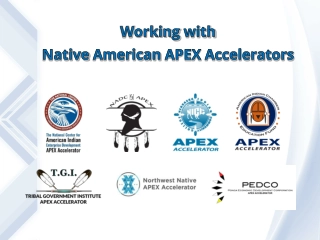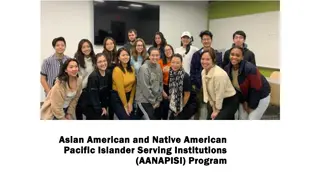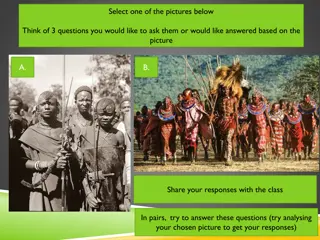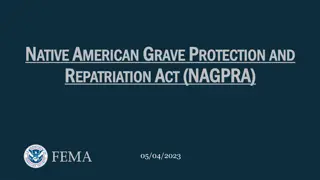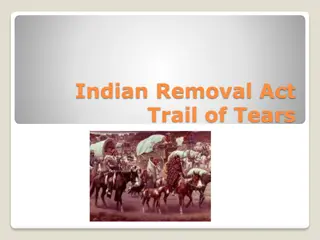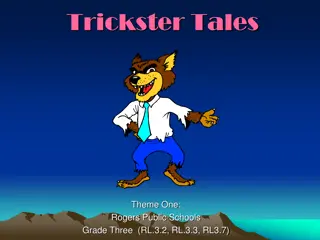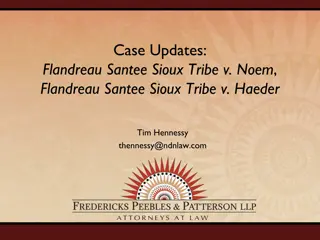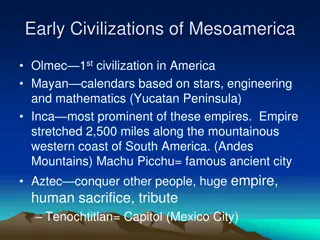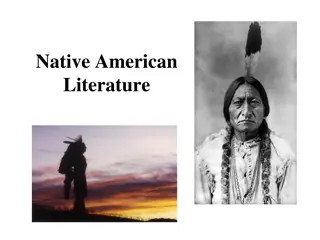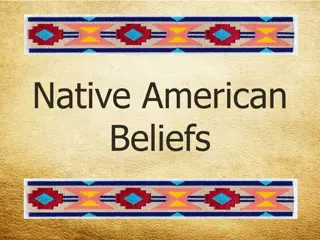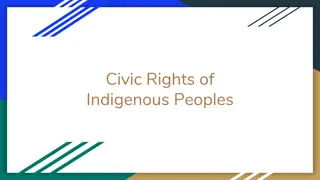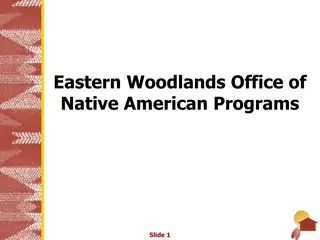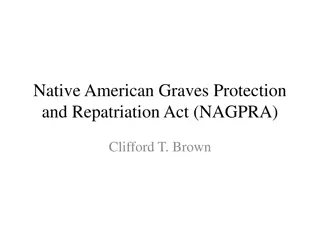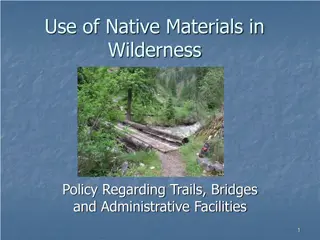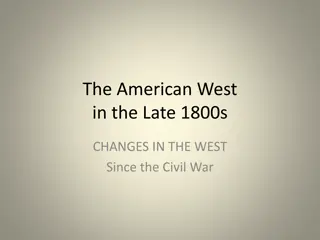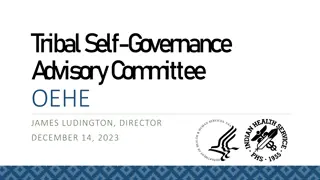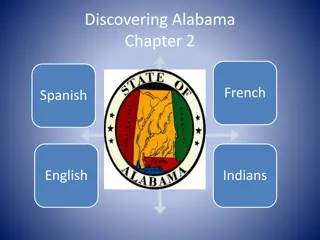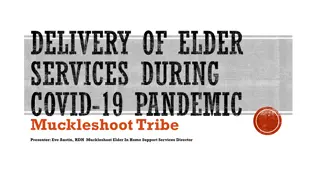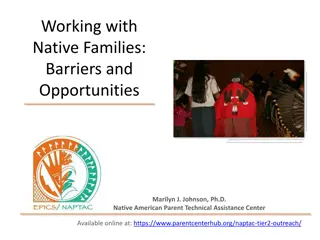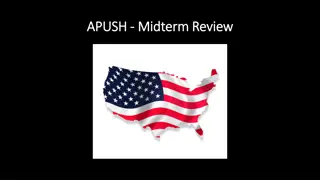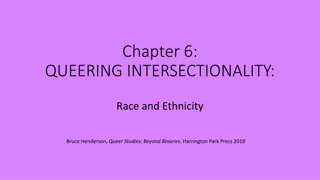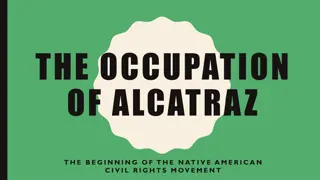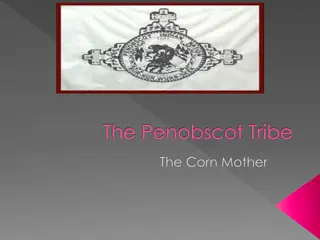ReuNify: A Comprehensive Analysis of React Native Android Apps
ReuNify is a program analysis project targeting React Native Android applications. It integrates JavaScript and native-side code into Jimple, facilitating static analysis. The tool addresses the challenges posed by the complex mechanisms of React Native and the transition to Hermes bytecode. With a
3 views • 24 slides
Native American APEX Accelerators Program Overview
The Native American APEX Accelerators Program, formerly known as PTACs, is a nationwide network of procurement professionals dedicated to assisting local businesses, including federally recognized Indian tribes and Alaska Native entities. Services are provided at no cost and aim to strengthen the de
1 views • 69 slides
Understanding Invasive Species in Northwest Michigan
Explore the impact of invasive species in Northwest Michigan through images and data on habitat support for butterfly and moth species, the transition of non-native plants to becoming native, and the definition of what makes a species invasive. Learn about the threats posed by non-native species and
4 views • 15 slides
Overview of AANAPISI Program in the United States
The Asian American and Native American Pacific Islander Serving Institutions (AANAPISI) Program aims to support institutions with a minimum of 10% Asian American and Native American Pacific Islander undergraduate enrollment. Currently, there are 54 funded AANAPISI institutions across 16 states and t
0 views • 13 slides
Exploring Native vs Hybrid App Development for Mobile Apps
Delve into the differences between native and hybrid app development options for mobile apps. Native app development involves utilizing specific programming languages tailored to the device and platform, leading to fast performance, advanced UI interactions, and support for multi-touch capabilities.
1 views • 53 slides
Discovering the Maasai Tribe: Life, Culture, and Environment
Explore the fascinating world of the Maasai tribe through images capturing their way of life in the Maasai Mara. Learn about their traditional homes, relationship with nature, and reliance on cattle for survival. Engage in discussions about their unique customs and practices in the African Savannah.
0 views • 22 slides
Cultural Awareness for Drug Courts Working with Native American Participants
Understanding the cultural nuances of Native American communities is crucial for Drug Courts collaborating with Tribal Healing to Wellness Courts. This involves acknowledging tribal sovereignty, regional and cultural differences, customs, spirituality, and communication styles unique to American Ind
0 views • 22 slides
Native American Repatriation and NAGPRA Overview
The Native American Graves Protection and Repatriation Act (NAGPRA) enacted since November 1990 establishes ownership of cultural items excavated on Federal or Tribal land. It requires returning such items to Native American descendants and affiliated tribes. The Act also criminalizes trafficking in
1 views • 8 slides
The Indian Removal Act and the Trail of Tears
President Jackson supported the policy of Indian removal, leading to the Indian Removal Act in 1830, which authorized the relocation of Native Americans to the West. This resulted in the Trail of Tears, a tragic event where many Native Americans, such as the Choctaw, Creek, and Cherokee, were forced
0 views • 18 slides
Office of Native American Programs at the U.S. Department of Housing and Urban Development
Office of Native American Programs (ONAP) at the U.S. Department of Housing and Urban Development works with tribal governments and other entities to address housing and community development needs in Indian Country. ONAP's mission is to ensure safe, decent, and affordable housing for Native America
1 views • 14 slides
Exploring Trickster Tales: The Hungry Spider and Ashanti Tribe
Discover the world of Trickster Tales through the Hungry Spider story from the Ashanti Tribe in Africa. Unveil the clever and mischievous characters, learn about the traits portrayed, and engage in critical thinking about the tale's moral lessons.
0 views • 23 slides
Understanding Native VLAN 1 in Mesh Ethernet Bridging
Mesh Ethernet bridging utilizes native VLAN 1 for the initial configuration, ensuring the RAP connects to the native VLAN ID 1 on a switch. This setup affects the communication between the RAP and the Map devices, as well as their connection to the controller. Misconfigurations related to VLAN taggi
0 views • 9 slides
FSST v. Noem: Legal Battle Over Casino Amenities Use Tax
The legal case of FSST v. Noem involves South Dakota's refusal to renew the Flandreau Santee Sioux Tribe's casino alcohol licenses due to the tribe's customers being required to pay a use tax on all purchases at the casino, including gaming amenities. The 8th Circuit Court ruled that the use tax on
0 views • 16 slides
Ancient Civilizations and Native American Cultures Overview
Early civilizations like the Olmec, Maya, Inca, Aztec, and North American cultures such as Hohokam, Anasazi, Adena, Hopewell, and Mississippian are explored. The diverse Native American tribes in Mesoamerica, North America, the West, Southwest, Pacific Northwest Coast, Great Plains, Far North, and E
1 views • 16 slides
Insights into Native American Literature
Native American Literature reflects rich cultural diversity with a history of stability and the challenges faced, leading to recognition and inclusion in the American literary canon. Characteristics include oral history and struggles in translation due to European influence.
0 views • 17 slides
Exploring Native American Beliefs and Spiritual Practices
Delve into the rich tapestry of Native American beliefs, traditions, and spiritual practices, including their diverse worldviews, sacred connections to nature, and unique cultural expressions. Discover the origins of terms like "Indian" and the vast linguistic diversity among different Nations. Cont
3 views • 13 slides
Native American Voting Rights and Indigenous Governance in the United States
Native American voting rights in the United States have a complex history, with Native peoples gaining the right to vote gradually over time. Despite legal allowances, barriers such as nontraditional addresses, voter registration obstacles, and ID laws still hinder their voting participation. The Na
2 views • 11 slides
Office of Native American Programs Overview
The Office of Native American Programs (ONAP) focuses on increasing the housing supply and creating economic opportunities for Native American families. ONAP provides grants for various programs and ensures fiscal integrity. The agency plays a crucial role in assisting tribes with housing provision,
0 views • 15 slides
Controversial Use of Native American Imagery in Sports Teams
Sports teams like the Washington Redskins, Atlanta Braves, Kansas City Chiefs, Cleveland Indians, and Chicago Blackhawks have faced criticism for their use of Native American imagery and mascots. This has sparked debates on cultural appropriation, racism, and the impact on Native American communitie
2 views • 8 slides
Exploring Native American Literature: Creation Stories and Themes
Delve into the rich world of Native American literature, focusing on creation myths, oral traditions, and cultural themes. Discover how these stories explain the origins of the world, human nature, and societal values, as passed down through generations. Explore key texts like "The World on the Turt
0 views • 32 slides
Understanding the Housing Improvement Program (HIP)
The Housing Improvement Program (HIP) is a grant program aimed at providing home repair, renovation, and replacement assistance to Native American and Alaska Native individuals facing housing challenges. HIP targets the neediest individuals to eliminate substandard housing and homelessness in Indian
0 views • 8 slides
Understanding the Native American Graves Protection and Repatriation Act (NAGPRA)
The Native American Graves Protection and Repatriation Act (NAGPRA) is a human rights/civil rights legislation aimed at protecting Native American cultural items and human remains. It requires federal agencies and museums receiving federal funds to inventory and repatriate certain items. The law has
0 views • 5 slides
Washington Irving: Father of American Fiction and Pioneer of American Romanticism
Washington Irving, an influential American author of the early 19th century, is revered as the Father of American fiction. Known for iconic works like "The Legend of Sleepy Hollow" and "Rip Van Winkle," Irving played a crucial role in establishing American literature as an independent art form. His
1 views • 14 slides
Forest Service Policy on Native Materials in Wilderness
This information outlines the use of native materials in wilderness areas, focusing on trails, bridges, and administrative facilities. It covers examples of structures using native materials, common questions surrounding material choices, guidelines for trail and wilderness managers, and Forest Serv
0 views • 31 slides
Squaxin Island Tribe General Welfare Program Overview
Overview of the Squaxin Island Tribe's General Welfare Program, including information on per capita benefits, enrollment process, qualifying expenses, key exceptions, documentation, payment methods, and examples of qualifying expenses for reimbursement.
0 views • 19 slides
The Grand Ronde Termination of 1954: Unjust Deed
In 1954, the Grand Ronde Tribe faced termination of federal recognition without consent, leading to loss of treaty rights, land, and tribal identity. This act was imposed despite the tribe's objections, highlighting a dark chapter in American history where Native American tribes were forcibly assimi
0 views • 13 slides
Impact of Westward Expansion on Native Americans in the Late 1800s
The late 1800s saw significant changes in the American West due to westward expansion after the Civil War. This expansion led to conflicts with Native Americans as more whites moved west in search of gold, farmland, and opportunities. Native Americans fiercely resisted being forced onto reservations
0 views • 20 slides
Disparities in Salary Between Native and Non-Native Speaking Teachers in China
The images depict the significant salary gaps between native and non-native speaking teachers in China, showcasing disparities in hourly wages, monthly pay, and overall salary hierarchy. The comparison highlights various factors contributing to these differences, including vacation time, workload, a
0 views • 11 slides
Update on Bipartisan Infrastructure Law (BIL) Implementation
The Executive Summary provides insights into the progress and challenges faced in implementing the Bipartisan Infrastructure Law (BIL) for Sanitation Facilities Construction (SFC) through the Indian Health Service (IHS). It outlines the allocation of funds, project milestones achieved, workforce enh
0 views • 16 slides
Exploring Early Alabama: Europeans, Trade, and Native American Relations
In Chapter 2 of Discovering Alabama, the impact of French, Spanish, and English settlers on the Native American populations is explored. Key vocabulary such as immunity, bartered, cartographer, and more are highlighted. The lesson also delves into reasons for conflicts between Europeans and Native A
0 views • 69 slides
Delivery of Elder Services During COVID-19 Pandemic by Muckleshoot Tribe
Elder services during the COVID-19 pandemic provided by Muckleshoot Tribe included medical alert, pharmacy delivery, transportation, nursing triage, in-home care, and more. The response strategies involved diagnosis, triage, and implementation of essential services with a focus on elder well-being a
0 views • 9 slides
Insight into Native American Parental Involvement in Education
Explore the impact of parental involvement on student achievement, early educational experiences of Native American parents, and present-day challenges and opportunities. Discover the benefits of family engagement, resources for connecting with Native American parents, and firsthand accounts highlig
0 views • 15 slides
Native American Cultures and European Colonization in APUSH Midterm Review
Explore key differences among Native American tribes pre-Columbus, noting similarities in matrilineal societies and religious practices. Delve into the impacts of European arrival on environment, culture, identity, and politics of Native Americans from 1492-1607, contrasting English, Spanish, and Fr
0 views • 61 slides
Exploring Queer Identities in Native American and African-American Communities
Delve into the nuanced intersections of race, ethnicity, and queerness within Native American and African-American communities. From the reclaiming of Two-Spirit identities to the presence of queer writers in literary spaces, this exploration sheds light on the complexities of identity, resistance t
0 views • 38 slides
Exploring Indiana: From Native American Tribes to Statehood
Indiana's history unfolds from the early Native American tribes in 8000 BC to European exploration and statehood. The region saw significant development during the Mississippian culture, and European settlers arrived in the 1670s. British rule persisted until the American Revolutionary War, shaping
0 views • 14 slides
Native American Resistance in the Battle of Little Bighorn
In the aftermath of the Civil War, Native American tribes clashed with the United States over land rights, leading to conflicts known as The Indian Wars. Despite some victories, Native Americans were ultimately overwhelmed by the superior weaponry of the US Army. The Battle of Little Bighorn in Mont
0 views • 9 slides
Understanding Cultural Influence on Delayed Child Sexual Abuse Disclosure in the Vhavena Tribe
Exploring the intersection of culture, tradition, and delayed disclosure of child sexual abuse within the Vhavena Tribe. The study delves into the complexities of disclosure, the unique context of CSA in cultural norms, and behaviors, guided by the Afrocentric theory. Methodology involves interviews
0 views • 15 slides
The Occupation of Alcatraz and the Native American Civil Rights Movement
The Occupation of Alcatraz marked the beginning of the Native American civil rights movement as tribes fought against forced relocation and government coercion. The Fort Laramie Treaty of 1868, the planned occupation in 1963, and subsequent events on the island illustrate the struggles and activism
0 views • 6 slides
American Literature Through the Ages
Explore the rich tapestry of American literature covering American Indian culture, New England Puritanism, the 18th century American Enlightenment, and the American Renaissance. Discover the oral traditions of American Indian tribes, the puritanical values of New England, the democratic origins of A
0 views • 17 slides
The Rich Heritage of the Penobscot Tribe and Its Cultural Significance
The Penobscot Tribe, descendants of the Algonquian tribe, have a rich heritage deeply rooted in their tribal origins and homelands. Known for their craftsmanship in making canoes, fishnets, and intricate beadwork, the tribe has a reputation for peacefulness and hospitality. The story of the Corn Mot
0 views • 25 slides

